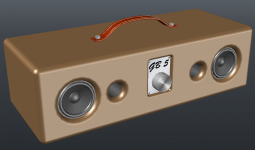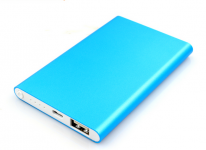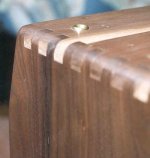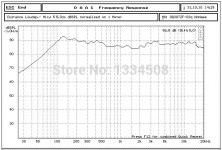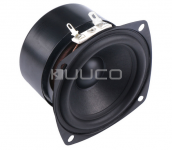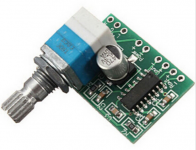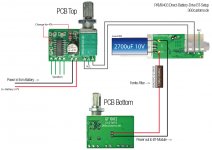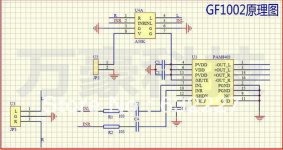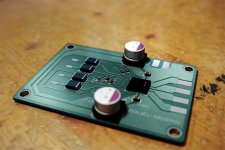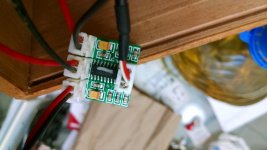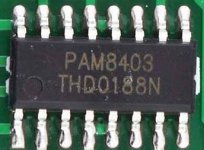I am planning a build for a 5V 6W Mini Boombox.
I ordered a PAM8403 Amp with Integrated Volume Control, 2 x 3inch 4Ohm Full Range Speakers (Up to 15W), a 5V 8000mAh Powerbank (Battery with charging system integrated), and a cellphone charger (5V 2A). Images Attached.
I'm planning a solid wood enclosure with 2 x 5.5L cabs, some good looking box joints on the corners, a partition that seals connectivity between the 2 speaker cabs, 2 x 30-40mm ports and a vintage looking Leather Handle (Think Fender Tweed Amp)
I ordered the above parts from AliExpress, but I'm from South Africa so I'm only expecting the stuff in a month or two. In the mean time it would be nice to get a discussion going to hash out some of the final details.
I ordered a PAM8403 Amp with Integrated Volume Control, 2 x 3inch 4Ohm Full Range Speakers (Up to 15W), a 5V 8000mAh Powerbank (Battery with charging system integrated), and a cellphone charger (5V 2A). Images Attached.
I'm planning a solid wood enclosure with 2 x 5.5L cabs, some good looking box joints on the corners, a partition that seals connectivity between the 2 speaker cabs, 2 x 30-40mm ports and a vintage looking Leather Handle (Think Fender Tweed Amp)
I ordered the above parts from AliExpress, but I'm from South Africa so I'm only expecting the stuff in a month or two. In the mean time it would be nice to get a discussion going to hash out some of the final details.
Attachments
Last edited:
Thanks for the input, I will give it a listen in the mock setup and if the bass is weak I will try your suggestion.
I see in your suggestion that you are using 3.7V power... using 4ohm speakers that only produces 1.3W @ 1% THD per speaker, that may be contributing (or rather not contributing) to the bass situation.
What did your setup sound like with more power? (The amp can handle input voltage up to 6V).
The power supply I'm using can output 2A at 5.2V and in theory this should yield slightly over 2.5W @ 1% THD per speaker (double compared to the setup you're showing). The speakers also have a pretty good low end response (for their small size and price), and I intend to build a half decent ported cabs (and isolating the speakers from each other) and I'll try to tune the cabs as low as possible to help deal with the fact that I'm using a very small amp.
I see in your suggestion that you are using 3.7V power... using 4ohm speakers that only produces 1.3W @ 1% THD per speaker, that may be contributing (or rather not contributing) to the bass situation.
What did your setup sound like with more power? (The amp can handle input voltage up to 6V).
The power supply I'm using can output 2A at 5.2V and in theory this should yield slightly over 2.5W @ 1% THD per speaker (double compared to the setup you're showing). The speakers also have a pretty good low end response (for their small size and price), and I intend to build a half decent ported cabs (and isolating the speakers from each other) and I'll try to tune the cabs as low as possible to help deal with the fact that I'm using a very small amp.
I'm not planning on adding bluetooth (maybe later I will) since I want to dedicate all the power from the battery to the sound output... 3.5mm jack is fine for input (for now).
You also have the option to control input gain from the playback device (in this case a phone) by adjusting the output volume.
You can also filter / shape the input a bit to increase bass response since most music apps have bass boost functions (which actually cuts the high frequencies and volume with it, I know), but all these options can be considered before hardware hacking the GF1002 board.
You also have the option to control input gain from the playback device (in this case a phone) by adjusting the output volume.
You can also filter / shape the input a bit to increase bass response since most music apps have bass boost functions (which actually cuts the high frequencies and volume with it, I know), but all these options can be considered before hardware hacking the GF1002 board.
Double the watts is just 3dB, to have it twice as loud you'll need 10x the power - so would say, barely noticeable. I use direct battery drive to avoid a mostly noisy step-up and to increase runtime. Mostly you won't run this chip at "high power". I bought this amp in a pack of ten, I mean this amp is more a "joke" than an amp 🙂 Sure, it works, but to my ears it's nothing special. But hey, I like them in their own special way. Will post some pics tomorrow. I have one build we're the amp is powered from pure capacitance, stacked two 25F (25,000,000uF) super caps in series. This 12F 5.4V tank is charged in 3 minutes from USB and then runs for about 45-50minutes at moderate levels down to 2.1V. Speakers are small 2" full range drivers in an old phones handset. 🙂
These chips don't offer much drive/headroom for solid bass at mid/higher levels so you need to get as much gain from the chassis/speakers and construction as possible. So having 96dB drivers rather than 85dB will do the trick. That's 10dB, or twice as loud.
These chips don't offer much drive/headroom for solid bass at mid/higher levels so you need to get as much gain from the chassis/speakers and construction as possible. So having 96dB drivers rather than 85dB will do the trick. That's 10dB, or twice as loud.
Last edited:
I like the original plan generally, but I'd add the bluetooth receiver anyway, since it's cheap (about $15 at Parts Express). It's power can be switched off when not being used, and a smartphone transmitting bluetooth wirelessly makes a nice remote control.
Generating bass outside (camping for example), takes a lot of power. "Baffle step" is severe. Turning up the bass when you only have 2 watts is likely to cause distortion at low listening levels to all frequencies, and the apparent bass increase will barely be noticable outdoors.
Personally, I'd put an active 4th order highpass (using opamps) ahead of the power amp, cutting off all bass below what the speaker can really do. Probably at 100HZ, so the rest of the frequency response would have most of the 2 watts to work with.
If I cared, I might build a separate woofer (maybe two 5 inch woofers in a closed box) with more power to go with that (at least 10 watts switchmode) (and maybe a passive radiator or two), and put a 40HZ 4th order highpass in that circuit, so no wasted power below 40HZ; energy you'll not likely perceive outdoors anyway.
My fast attack/slow decay RTA taught me that with real world program material, energy at all frequencies comes in envelops that usually contains significant energy at low bass frequencies (unless it's already been bandwidth limited, which is not always the case). You're not likely to perceive that energy in a boombox outdoors, but it uses up some of your headroom. With a 2 Watt amp this could be significant.
I've wanted to build something like this too, but don't know what 3 or 4 inch driver has good fidelity AND good efficiency. It seems you can have one or the other, but not both.
Generating bass outside (camping for example), takes a lot of power. "Baffle step" is severe. Turning up the bass when you only have 2 watts is likely to cause distortion at low listening levels to all frequencies, and the apparent bass increase will barely be noticable outdoors.
Personally, I'd put an active 4th order highpass (using opamps) ahead of the power amp, cutting off all bass below what the speaker can really do. Probably at 100HZ, so the rest of the frequency response would have most of the 2 watts to work with.
If I cared, I might build a separate woofer (maybe two 5 inch woofers in a closed box) with more power to go with that (at least 10 watts switchmode) (and maybe a passive radiator or two), and put a 40HZ 4th order highpass in that circuit, so no wasted power below 40HZ; energy you'll not likely perceive outdoors anyway.
My fast attack/slow decay RTA taught me that with real world program material, energy at all frequencies comes in envelops that usually contains significant energy at low bass frequencies (unless it's already been bandwidth limited, which is not always the case). You're not likely to perceive that energy in a boombox outdoors, but it uses up some of your headroom. With a 2 Watt amp this could be significant.
I've wanted to build something like this too, but don't know what 3 or 4 inch driver has good fidelity AND good efficiency. It seems you can have one or the other, but not both.
I know the PAM8403 is not the best amp around, but this project is a 5V project (Check the title) and as far as 5V amps go this is one of the most widely used in a DIY sense thus giving me lots of people like you to tell me how crap it is and how to make it sound better.
I bought the drivers so that if this project sound crap I can upgrade to a 2x10W @ 12V solution, but first I want to see how much sound can you squeeze out of 5V 1A.
Bass is the biggest problem, but luckily I will mostly be using this setup indoors (if it works). I am more than willing so sacrifice some volume (in the higher frequencies) for more bass, but the suggestion to filter out the very very bottom end (that the drivers can't handle) is a really good suggestion, thanx Bob. That 4th order 100Hz filter, how & where would you implement it? (See schematic attached) I see there are already some caps on the input (C2 + C4), this a good place?
I thought about doing a separate woofer, but this (like bluetooth) can also be added later.
For now I am very interested to see how well we can make a PAM8403 and 2 speakers sound, so any suggestions regarding filters and cab config / construction are very welcome.
I bought the drivers so that if this project sound crap I can upgrade to a 2x10W @ 12V solution, but first I want to see how much sound can you squeeze out of 5V 1A.
Bass is the biggest problem, but luckily I will mostly be using this setup indoors (if it works). I am more than willing so sacrifice some volume (in the higher frequencies) for more bass, but the suggestion to filter out the very very bottom end (that the drivers can't handle) is a really good suggestion, thanx Bob. That 4th order 100Hz filter, how & where would you implement it? (See schematic attached) I see there are already some caps on the input (C2 + C4), this a good place?
I thought about doing a separate woofer, but this (like bluetooth) can also be added later.
For now I am very interested to see how well we can make a PAM8403 and 2 speakers sound, so any suggestions regarding filters and cab config / construction are very welcome.
Attachments
I never said it's crap, but sound experience is limited as well as headroom in the bass range.
If you want to pay me the shipping costs ($4), i'd send you one of my first MAX9704 boards i made. It's the successor of the amp shown followed and the predecessor of my MAX9709 boards. (Of course, you'll need a small stepup then)
https://www.youtube.com/watch?v=t2Z3ogntpiA
https://www.youtube.com/watch?v=0ytBuD9dgh0
If you want to pay me the shipping costs ($4), i'd send you one of my first MAX9704 boards i made. It's the successor of the amp shown followed and the predecessor of my MAX9709 boards. (Of course, you'll need a small stepup then)
https://www.youtube.com/watch?v=t2Z3ogntpiA
https://www.youtube.com/watch?v=0ytBuD9dgh0
Attachments
I never said it's crap, but sound experience is limited as well as headroom in the bass range.
If you want to pay me the shipping costs ($4), i'd send you one of my first MAX9704 boards i made. It's the successor of the amp shown followed and the predecessor of my MAX9709 boards. (Of course, you'll need a small stepup then)
https://www.youtube.com/watch?v=t2Z3ogntpiA
https://www.youtube.com/watch?v=0ytBuD9dgh0
I don't think you understand, when I say 5V I mean using a Class D Amp with a 5V supply voltage, not stepping up a 5V supply to power an amp that normally uses 12 - 16V. That's like saying the PAM8403 is a 220V Amp when you use a transformer to produce 5V DC from mains.
I don't like stepping up from 5V since the whole point of class D is efficiency. If I don't even want to add bluetooth because I want to conserve power, how would I justify a step-up circuit over simply adding a larger battery, say 12V...?
This thread is for a portable speaker that uses an amp with supply voltage around 5V 1A (i.e. 2x3W). Please don't hi-jack the thread, there are already plenty of 10-20W projects on here.
If you know of a better 5V 2x3W Stereo amp (preferably Class D since we're using batteries), please feel free to make a suggestion... Else rather try to focus on the bits around the amp instead
Here's something to look at, I have a couple of these but I've only used one for a mini guitar amp. The price it right though. ($3.48)
Cheap Mini Digital 3W+3W Amplifier Module Board - Green
Cheap Mini Digital 3W+3W Amplifier Module Board - Green
Here's something to look at, I have a couple of these but I've only used one for a mini guitar amp. The price it right though. ($3.48)
Cheap Mini Digital 3W+3W Amplifier Module Board - Green
Thanx Marty, what chip does it use? I can't see clearly on the DX Images... Any chance you can take a closeup top view of one of your boards?
I can't find any ready made boards, but the TPA2008D2 looks like a good choice for your app.
http://www.ti.com/product/tpa2008d2
"Extremely Efficient Third Generation 5-V Class-D Technology
Low Supply Current, 7 mA
..."
http://www.ti.com/product/tpa2008d2
"Extremely Efficient Third Generation 5-V Class-D Technology
Low Supply Current, 7 mA
..."
Unfortunately, they painted over the part number lol! I have attached a close up for you to look at anyway.
That chip looks suspiciously similar to a PAM8403 Package... mmmmh 😕
Attachments
Yeah I know! I thought the same thing after taking a closer look at the amp you already have. Who are they trying to fool right?
I can't find any ready made boards, but the TPA2008D2 looks like a good choice for your app.
http://www.ti.com/product/tpa2008d2
"Extremely Efficient Third Generation 5-V Class-D Technology
Low Supply Current, 7 mA
..."
I also looked at the TPA2008D2, but the PAM8403 seems slightly more powerful on paper.
The TPA produces 2.5W into 3Ω at 1% THD and 3W at 10%. 3Ω speakers are not that common so I would probably have to use 4Ω and that will reduce the output by around 700mW. This does not sound like a lot, but in a small system like this, 25% less power is substantial.
The PAM chip produces 2.5W into 4Ω at 1% THD and 3.2W at 10% THD.
Apart from the fact that the TPA is slightly less powerful than the PAM, the PAM is widely available in various ready-to-go board configurations that includes a volume control and some very limited filtering, etc.
I also looked at the TPA2008D2, but the PAM8403 seems slightly more powerful on paper.
The TPA produces 2.5W into 3Ω at 1% THD and 3W at 10%. 3Ω speakers are not that common so I would probably have to use 4Ω and that will reduce the output by around 700mW. This does not sound like a lot, but in a small system like this, 25% less power is substantial.
The PAM chip produces 2.5W into 4Ω at 1% THD and 3.2W at 10% THD.
Apart from the fact that the TPA is slightly less powerful than the PAM, the PAM is widely available in various ready-to-go board configurations that includes a volume control and some very limited filtering, etc.
Yes, agreed. I figured it would be worth a mention because the tpas are efficient. You could test with the evaluation module for the low cost of $50 😉
I'll be interested to hear how it turns out! I'm planning on something very similar myself.
The TPA produces 2.5W into 3Ω at 1% THD and 3W at 10%. 3Ω speakers are not that common so I would probably have to use 4Ω and that will reduce the output by around 700mW. This does not sound like a lot, but in a small system like this, 25% less power is substantial.
So are we talkin about 2.3W vs. 2.5W?
Maybe, i repeat myself but a difference of 3dB is barely hearable.. 2.3W -> 4.6W or 2.5W -> 5W
Anyway, good luck for your project. Like to see the results then.
Please don't hi-jack the thread, there are already plenty of 10-20W projects on here.
Don't worry.
I don't like stepping up from 5V since the whole point of class D is efficiency.
Thats why i dont step-up from 3.7V Li+ to 5V. Your 5V batterypack is actually a step-up-system, maybe a noisy one. Do you know the efficiency of this pack - guess not.
Anyway, like to see the results then.
The TPA produces 2.5W into 3Ω at 1% THD and 3W at 10%. 3Ω speakers are not that common so I would probably have to use 4Ω and that will reduce the output by around 700mW. This does not sound like a lot, but in a small system like this, 25% less power is substantial.
So are we talkin about 2.3W vs. 2.5W?
Maybe, i repeat myself but a difference of 3dB is barely hearable.. 2.3W -> 4.6W or 2.5W -> 5W
I think you missed the part where the TDA chip's output is rated at 2.5W into 3Ω... using 4Ω speakers will limit power output by 25%.
Another thing, when you use the PAM chip with 3.7V, you only have an output of 1.3W @ 1% THD compared to 2.5W when using 5V. I understand that 3db isn't a lot of sound, but operating an amp at it's minimum supply voltage may affect certain frequencies of the output (like maybe, bass) more than others...
Back to your original suggestion, I'm probably going to have to limit the input gain anyways since Class D has the worst sounding distortion of all amps (this means I agree with you)... but, simply changing the input resistors from 10k to 47k will limit all frequencies, including bass. Running an equalizer preset to boost bass and then limiting the playback volume on the music player / phone is a much easier way to control the input gain and shape the sound better for the power stage.
Thats why i dont step-up from 3.7V Li+ to 5V. Your 5V batterypack is actually a step-up-system, maybe a noisy one. Do you know the efficiency of this pack - guess not.
Anyway, like to see the results then.
Valid Point, I overlooked this fact. I will test the setup using a custom 5V battery pack and compare the results with the 3.7V Step-up pack... It might be interesting to compare the sound quality.
I never said it's crap, but sound experience is limited as well as headroom in the bass range.
If you want to pay me the shipping costs ($4), i'd send you one of my first MAX9704 boards i made. It's the successor of the amp shown followed and the predecessor of my MAX9709 boards. (Of course, you'll need a small stepup then)
https://www.youtube.com/watch?v=t2Z3ogntpiA
https://www.youtube.com/watch?v=0ytBuD9dgh0
These videos cannot be playing original sound from the video recorder...? Or it is a REALY good mic...?
Back to your original suggestion, I'm probably going to have to limit the input gain anyways since Class D has the worst sounding distortion of all amps (this means I agree with you)... but, simply changing the input resistors from 10k to 47k will limit all frequencies, including bass. Running an equalizer preset to boost bass and then limiting the playback volume on the music player / phone is a much easier way to control the input gain and shape the sound better for the power stage.
More (hardware) gain -> more noise pickpup + (typical) lower input impedance -> needs greater cap values to maintain lower x-over-frequency.
I have the fact that the BT modules output level is already enough to overdrive the PAMs input/output capability. So i reduced the gain for this reason and to have the full dynamic range (gain control -> potentiometer/software)
These videos cannot be playing original sound from the video recorder...? Or it is a REALY good mic...?
It's the used programming material but overdubed from the original source. (So, no mic)
Last edited:
- Status
- Not open for further replies.
- Home
- Amplifiers
- Class D
- 5V Portable Amp: Pre-build Discussion
